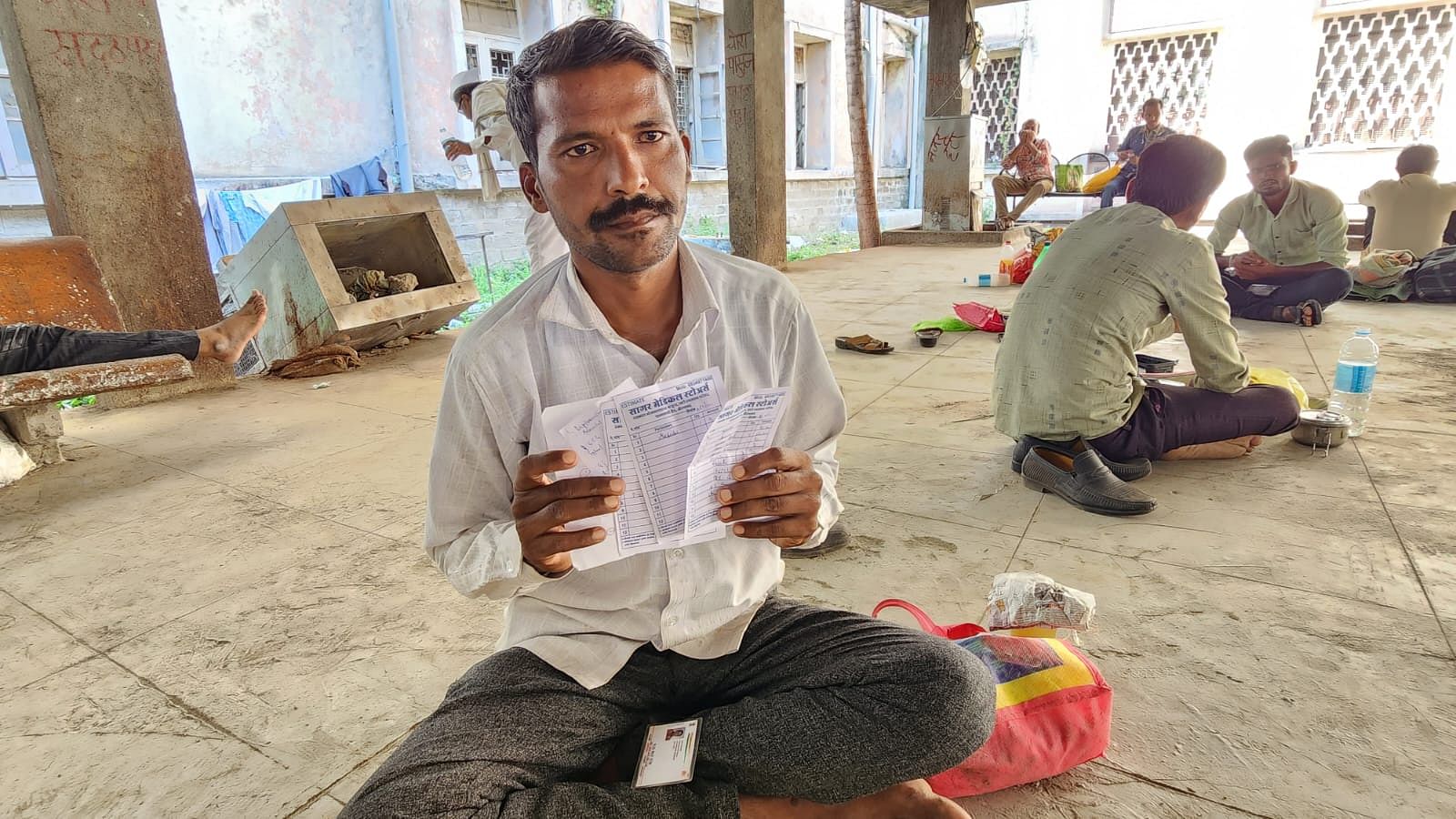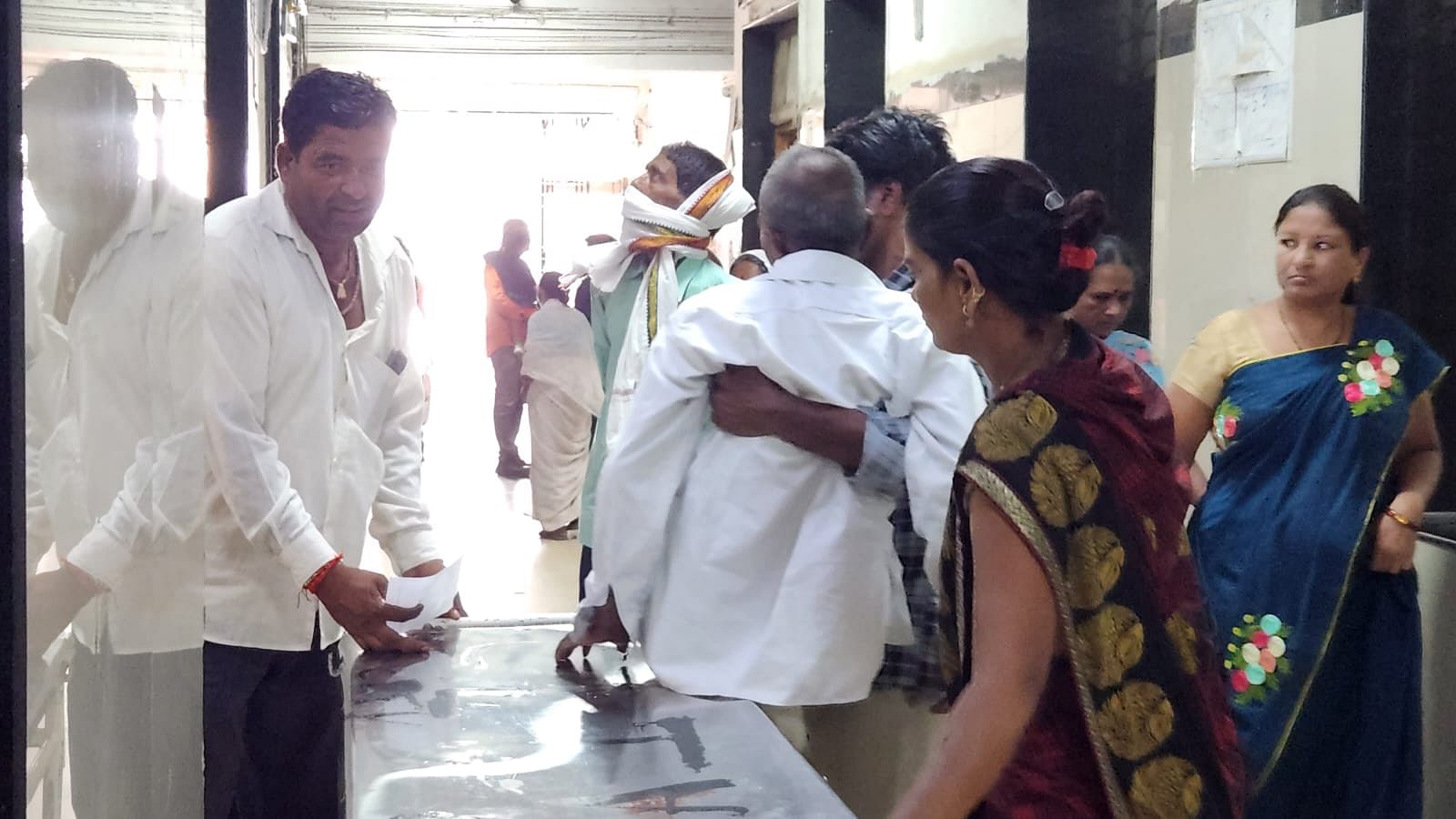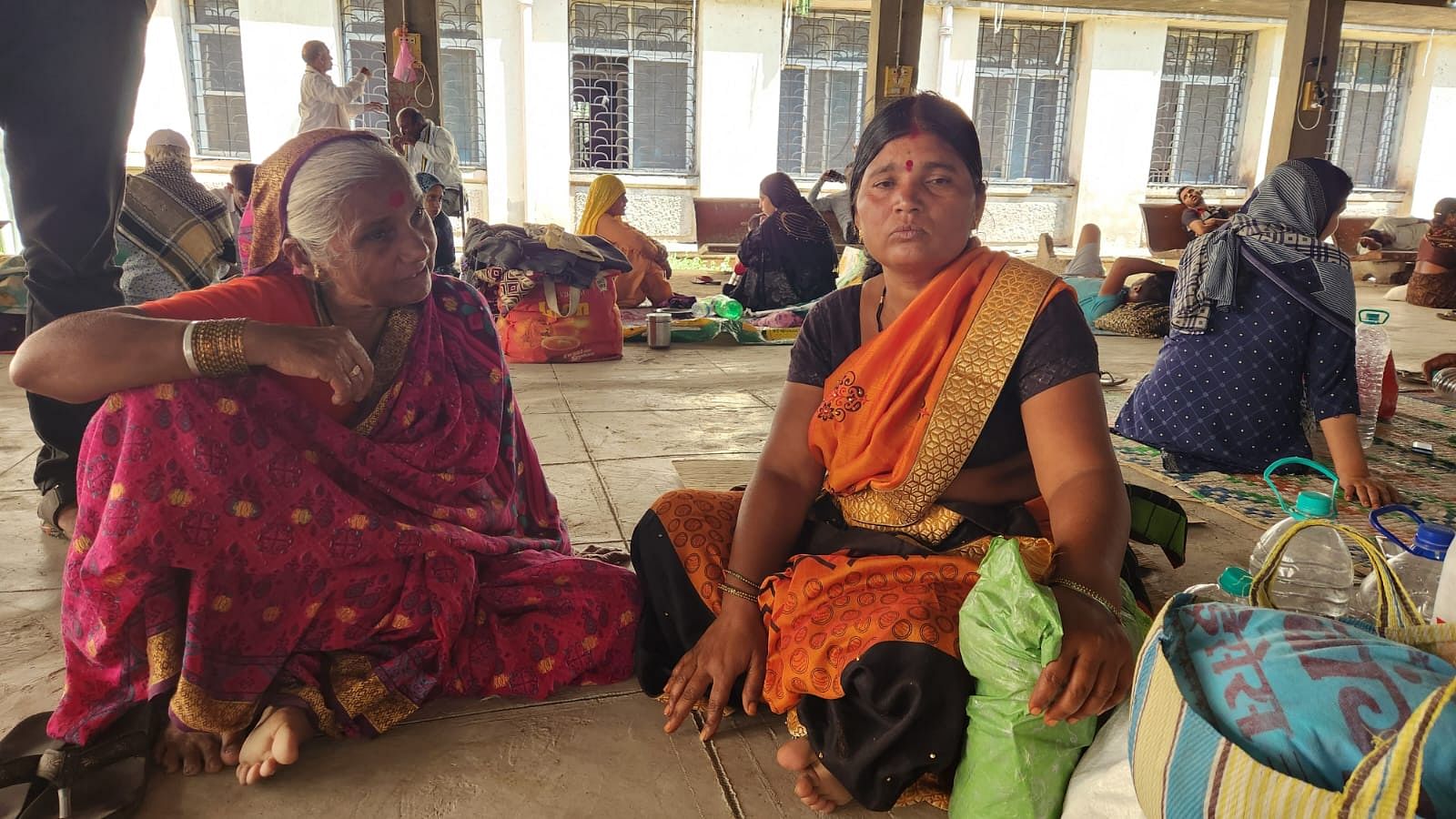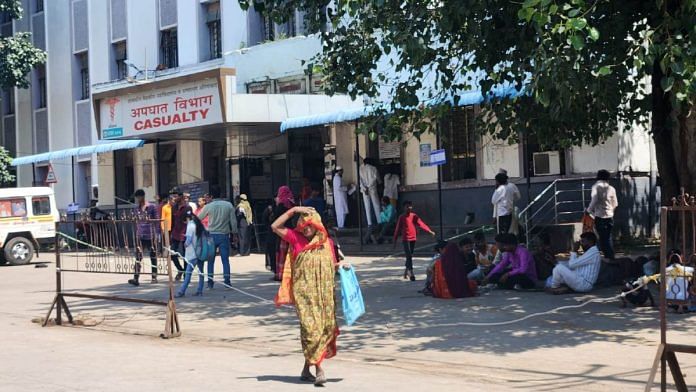Chhatrapati Sambhajinagar: Tension is writ large on Gangaram Bichare’s face as he flips through his wallet. It takes a few minutes, but the villager from Varodchatha, about 65 km from Chhatrapati Sambhajinagar, finally finds what he is looking for.
It’s a receipt for medicines for his 7-year-old son, who has been admitted at the Government Medical College and Hospital in Chhatrapati Sambhajinagar, popularly known as Ghati hospital, for the past one week for surgery.
The receipt — for an injection — is from a chemist in a neighbouring area, Aurangpura.
“They [Ghati government hospital] said this injection is not available right now at the hospital, so you have to go outside to get it, else your time will be wasted,” Bichare told ThePrint, adding that he had shell out Rs 100 for an auto ride to get the injection worth Rs 170.”

“They told me to procure all the medicines from outside. It has so far cost me around Rs 2,500,” he added.
Mehraz Patel, a member of the management committee (‘abhyagat mandal’) at the Ghati medical college, admits there is a shortage of medicines at the facility.
“Machinery is not in large numbers. CT scan, MRI will take time. The inadequacy of medical equipment is leading to delayed treatment, and people are forced to go to private facilities,” she added. “This is not a doctor problem, but of the system.”
The Ghati government hospital is among the public healthcare facilities in Maharashtra — including Nanded Government Medical College and Hospital — that have courted headlines over the past few weeks over a suspicious number of patient fatalities.
The incidents have once again brought to light some of the factors that have been known as the bane of government hospitals in India for years.
These include towering vacancies, patients who are severely ill coming to government facilities as a last resort, and delay in release of sanctioned funds for operations.
There have been allegations of medicine shortage as well.
In the case of Nanded, CM Eknath Shinde and Medical Education Minister Hasan Mushrif have denied this, as has the dean of the hospital.
However, in Aurangabad, patients and staff who spoke to ThePrint talked about the problems faced buying and procuring medicines. Health activists, meanwhile, cite the government’s “half-hearted” attempt to plug gaps in the state’s procurement policy.
ThePrint reached Dr Dilip Mhaisekar, director of the Directorate of Medical Education and Research (DMER) who is also the Dean of the Nanded government medical college, for comment, but the calls went unanswered. Calls to Mushrif went unanswered as well.
Speaking to ThePrint, retired principal secretary Mahesh Zhagde described the problem facing Maharashtra government hospitals as “holistic” in nature.
“First of all, a proper study needs to be done on the number of patients coming to the hospital and then whether there are adequate beds, equipment… and whether the staff is well trained to handle the influx of patients.”
Secondly, the medicines need to be monitored, he added. “What type of medicines are required and if the procurement of medicines is done on time and properly,” he said.
The Bombay High Court has taken suo motu cognisance of the hospital deaths, and came down heavily on the state government last week.
“The state cannot escape by saying there is burden. You are the state,” it said. “You cannot shift the burden or responsibility to the private players.”
Also Read: Maharashtra Oppn calls for health minister to resign after Nanded hospital deaths — ‘not first time’
A change in Maharashtra procurement policy
In 2017, the state government set up a wing at state-owned Haffkine Biopharmaceutical Corporation to procure medicines as well as medical devices and equipment, and distribute them across various medical colleges, and hospitals.
Every hospital, however, was allowed to use 10 percent of funds to procure medicines and equipment to tide over any lag or emergency.
A government officer requesting anonymity said procurement through Haffkine regularly resulted in delays.
“We used to give them the requirements and we were allowed to spend 10 percent of funds in case of emergency or delays from Haffkine. But the orders used to be delayed for 3-4 months and we had to then keep it [the medicines] quarantined for another month to check it,” the officer said.
They used to give medicines in bulk, but, if the requirement was less, the rate used to go up, another officer said, requesting anonymity.
The two officers said that, every year, hospitals would send their requirements to Haffkine by March. Because of the delays, they added, various hospitals used to procure locally.
As the delays came to the government’s notice, it decided to set up another single-point source of procurement for medicines and medical devices.
To this end, in March 2023, the state government passed the Medical Goods Procurement Authority Act.
According to the Act, all procurement and supply of medicines, medical equipment, devices and goods was to be done by the eponymous authority.
Six months down the line, the law’s implementation itself hangs fire.
The body, for one, does not have any chairperson/CEO, a fact also noted by the Bombay High Court.
“Till date a full-fledged CEO of the medicine procurement authority has not been appointed, and only an additional charge has been given to another officer,” the court said, directing the state government to make the appointments within two weeks.
The government subsequently said the appointments will be made on an urgent basis.
Meanwhile, chaos continues at the Aurangabad hospital.
One of the doctors at Ghati hospital told ThePrint that its capacity is to treat over 1,100 patients daily, but they see an influx of around 2,000. “The government gives us medicines to treat only 1,177 patients, so how do we treat patients?” the doctor said, requesting anonymity.
On Friday, the management committee wrote a letter to the hospital (a copy of which is with ThePrint) where it says that, for the past five months, about Rs 5 crore has been sanctioned via the District Planning Development Committee to procure medicines but it hadn’t been done yet.
Haffkine also allegedly did not procure any medicines for this year, according to the letter.
ThePrint has reached Haffkine via email for a response but no comment has been received so far.
“Shortage of medicines is a recurrent problem in Maharashtra,” said health activist Dr Abhijit More.
According to More, “because of the arbitrary purchase of medicines and costly medicines earlier, the government started following the Tamil Nadu Medical Service Corporation (TNMSC) model to enhance transparency in the system”.
“But it was implemented half-heartedly. So, the medicines that should be there in the hospitals are not easily available and people have to purchase those medicines from outside,” he added.
The government, More said, “does not have a consistent policy around medicine procurement and it keeps on changing from time to time, creating confusion”.
Also Read: Thane civic hospital where 18 people died in 24 hours functioning over capacity, admin admits
Legacy issues
That infrastructural and staff issues plague the Ghati medical college is evident in scenes outside the hospital — many patients in wheelchairs were being ferried by their relatives instead of staff members.
Uddhav Bhasate, a farmer from Paithan, said he had to push a stretcher carrying his pregnant wife on his own.

“They didn’t have anyone to help us. I put my pregnant wife on the stretcher and took her inside the hospital,” he added, saying he was also asked to arrange a bottle of blood from outside during the delivery even as “they took Rs 300 from me in case they need to arrange a bottle of blood in case of an emergency”.
“They ask us to get the medicines from outside 80 percent of the time,” he said.
Usha Bhangal, who came from Buldhana, offered another story of despair.
Packing up to leave the premises after a month, she said the family will have to look for another facility for the treatment of her daughter’s infant son, who has a hole in his heart.

“Now, they say ‘we don’t have specialised doctors for this problem here’. We have been forced to go to a private hospital,” she added.
“Such a big hospital and they don’t have a doctor for us? We have to get sonography done, but they are not giving us an appointment as they say they don’t have dates anytime before 18 October,” she said.
Abhay Taksal, human rights activist in Marathwada region, said this was the condition at hospitals across Maharashtra.
“We didn’t have any wheelchairs, or stretchers earlier here. NGOs and other civil society members pitched in to get it. So, how will the system function, who is responsible for this?” he added.
In its observations, the Bombay High Court said the health sector in Maharashtra is clearly in decline, pointing out that the allocation for 2020-21 was 4.78 percent (of total budget), 5.09 percent in 2021-22, 4.24 percent in 2022-23, and 4 percent in 2023-24.
As a reason for the deaths at hospitals, the government told the high court that patients are often brought there when they have exhausted their options at civil or private hospitals.
Doctors agreed.
“The patient load is higher in government medical colleges. The death is not because of shortage of medical services but because the patients who come here are already in terminal stages after getting treated in private and other civil hospitals,” Dr Sanjay Rathod, Dean of Ghati hospital, told ThePrint.
“Our daily death is 14 on average against our influx of over 2,000 patients,” he added. “We treat 99 percent of our patients.”
Another senior doctor, requesting anonymity, said medical colleges’ primary job is to teach medical students, but because they cannot refuse patients, they admit them in the hospital.
“At our hospital, we get an influx of 2,000 patients daily and the death count is about 14-15 on average, but why don’t you see the number of patients that have recovered and our recovery rate of 99%,” said a doctor at Ghati medical college who did not wish to be named.
Vacancies are another issue.
In August, Maharashtra health minister Tanaji Sawant said almost 11,000 posts in the C and D categories in various government hospitals and health institutions will be filled soon.
As many as 30 percent of positions are vacant at Ghati medical college, according to the management committee’s letter. Of these, the post of medical secretary, 22 medical officers, and that of a resident medical officer have been vacant for 12 years, it said.
There are 320 class-4 vacancies, of which 115 have been “outsourced”, although the dean says the vacancies will be filled within a month.
In Nanded medical college, there are 47 vacancies against 325 sanctioned posts, including for professors, assistant professors, associate professors, and Class-3 and -4 positions. There are 48 vacancies against 97 sanctioned posts for senior residents, according to the report of a committee formed to look into the Nanded deaths, submitted in court Friday.
Experts say outsourcing of hospital work could be problematic.
“If you are outsourcing the staff, then your supervising authority should be very stringent. Now you don’t have the executing and supervising capacity. And so the system is collapsing,” said More.
“The government has key roles in health and education and they have to take an active role in it.”
Funds are said to be another problem.
At Ghati hospital, Rs 30 crore was demanded by the authorities for their annual expenses, but the government sanctioned only Rs 10 crore, and so far “only a meagre amount” has been released, sources at the hospital said.
‘Political will is important’
Another issue, according to experts, is doctors’ private practice.
“For the past four months, doctors have not been paid on time,” said Patel. “So, in that case, some of them work outside and do their own practice and that is one of the main problems as well.”
In a public health system, Taksal said, “the best of the best doctors should be available at a good salary so that they can stay back and work at the hospitals instead of giving priority to private practices”.
“Political will is important to change this system and strengthen the public health system,” he added. “There should be faith in these hospitals for people to first come to the government hospitals and not treat it like it’s the last option.”
Zhagade said, for long, the problem has been of the bureaucracy and their “lack of will”.
“This is basically a governance issue going on for a long time. This is a major failure and people are bearing the brunt of it. I think it is the responsibility that falls on bureaucracy and government staff,” said Zhagade.
(Edited by Sunanda Ranjan)
Also Read: Agra hospital gets clean chit, govt panel says 16 deaths not due to ‘mock drill’ over oxygen supply



